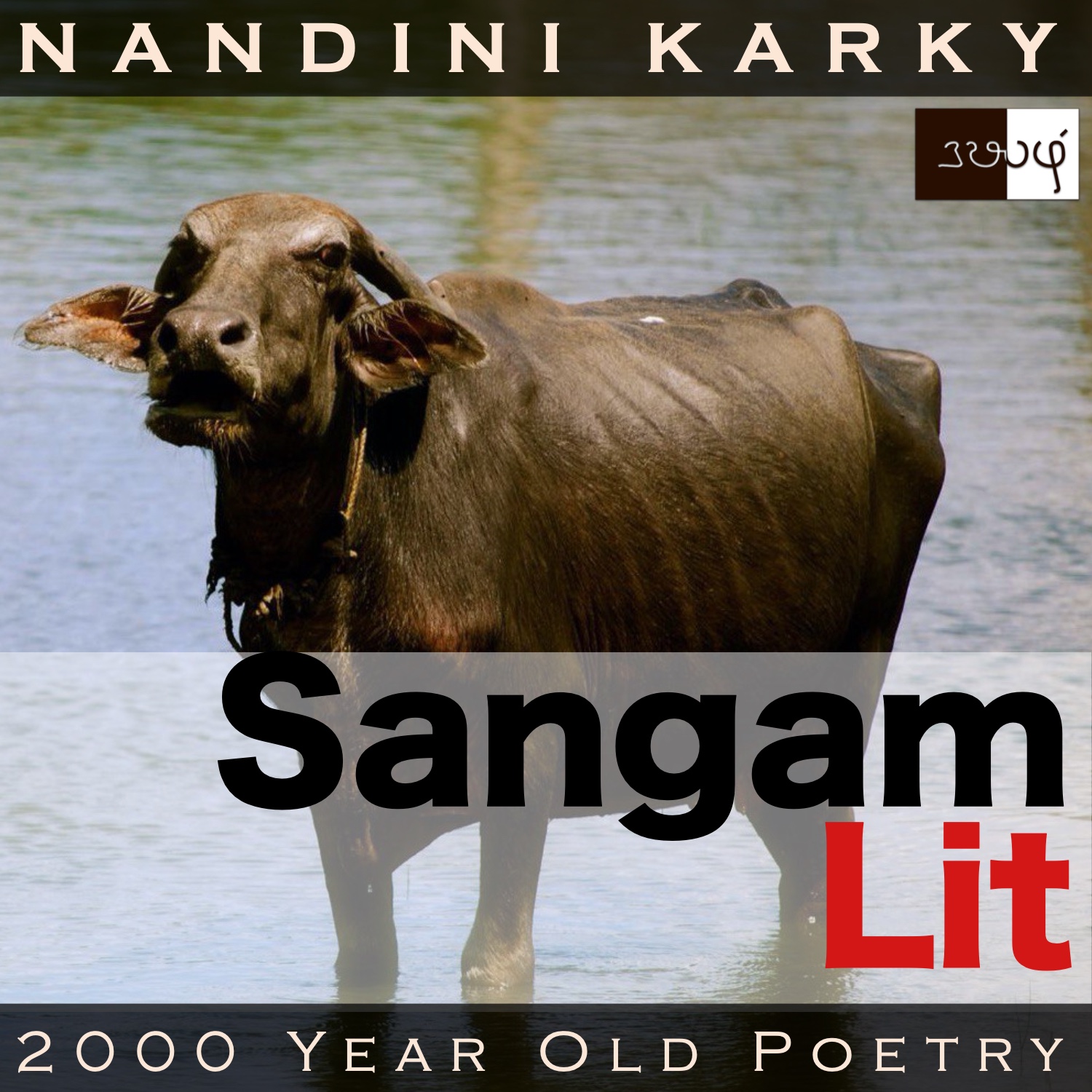Podcast: Play in new window | Download
Subscribe: Apple Podcasts | Spotify | Amazon Music | Android | iHeartRadio | TuneIn | RSS | More

In this episode, we follow the movements of a buffalo to learn the reason for a lady’s anger, as depicted in Sangam Literary work, Natrinai 260, penned by Paranar. Set in the agricultural regions of ‘Marutham’, the verse speaks in the voice of the lady to the man, conveying that she’s still vexed with him, unable to forget his recent behaviour.
கழுநீர் மேய்ந்த கருந் தாள் எருமை
பழனத் தாமரைப் பனிமலர் முணைஇ,
தண்டு சேர் மள்ளரின் இயலி, அயலது
குன்று சேர் வெண் மணல் துஞ்சும் ஊர!
வெய்யை போல முயங்குதி: முனை எழத்
தெவ்வர்த் தேய்த்த செவ் வேல் வயவன்
மலி புனல் வாயில் இருப்பை அன்ன, என்
ஒலி பல் கூந்தல் நலம் பெறப் புனைந்த
முகை அவிழ் கோதை வாட்டிய
பகைவன்மன்? யான் மறந்து அமைகலனே!
The verse opens with ‘கழுநீர் மேய்ந்த கருந் தாள் எருமை’ bringing the hero of the verse, ‘a black-legged buffalo that’s feeding on a red waterlily’ right before our eyes. In addition to the waterlily, we also get to see the ‘பழனத் தாமரை’ referring to ‘a lotus growing in the fields’. The phrase ‘தண்டு சேர் மள்ளர்’ sketches the image of ‘hefty warriors wielding clubs in their hands’. Talking of warriors, we get to meet ‘செவ்வேல் வயவன்’, ‘the red-speared warrior’, referring to the Sangam King Viraan, who ruled over the city of ‘இருப்பை’. The phrase ‘கோதை வாட்டிய பகைவன்மன்’ talks about ‘an enemy who made a garland fade’ and intrigues our curiosity. The verse ends with ‘யான் மறந்து அமைகலனே’ meaning ‘I have forgotten not’. That reminds us it’s time to learn more!
The man and lady had been leading a happy, married life, when the man took to keeping the company of a courtesan. One day, the man returns home to his wife. The lady turns to him and says, “O lord of the farmlands, in whose domain, the black-legged buffalo, disliking the cool lotus flower that blooms in the field, feeds on the red waterlily, and then walking like a warrior wielding a club, moves to the mound-like white dunes and sleeps therein! You embrace me as if you are full of love. My luxuriant tresses are akin to the town of Iruppai, on the banks of the flourishing river, the city of the red-speared warrior king, who has brought ruin to his enemies on the battle-field. O lord, aren’t you the enemy, who made the garland of flower buds that adorned these tresses of mine to fade away? I have not forgotten this!” With these words, the lady conveys that she is aware of the man’s relationship with the courtesan and that her anger has not ebbed for her to accept his advances.
Now, for the details! The lady begins her conversation with the man by talking about a buffalo that seems to be avoiding the fresh bloomed, cool and moist lotus flower in the fields and instead, goes in search of red waterlilies blooming in wayward ponds. After having a hefty meal of those waterlilies, strutting about like a soldier, who has seen success in a battle, the buffalo walks to the white sand dunes near the river bed and sleeps there. The lady goes into this lengthy description as if to talk about the man’s domain but she conceals a story within, which we will unravel in a moment. After this description, she turns to the man and mentions that he seems to be approaching her as if he’s full of love. Then, she talks about how he caused the garland of fresh buds on her thick tresses to fade. She simply doesn’t call the tresses as tresses but introduces us to a historical character ‘Viraan’, a Sangam king, a mighty warrior, who brings utter ruin to his foes and is known as the ‘red-speared one’! We also glimpse at his city of ‘Iruppai’, which is said to be on the fertile banks of a flowing river. The lady talks about this king to place in parallel, her beautiful tresses to this king’s rich city. She calls the man an enemy, who thus brought sadness to her and concludes saying that she has not forgotten this!
Returning to that scene involving the buffalo, the lady mentions the activities of the animal as a metaphor for what the man has been doing. Instead of living a happy life with the field lotus, which is the lady, he takes to seeking the red waterlily, the courtesan. His absence away from home, as he took to staying in the courtesan’s home, has brought much distress to her and she is still unable to let go of that memory of what happened. This is a dream-like verse where we go following a buffalo and find the man instead! If the same comparison between a man and a buffalo were used today, it would lead to hilarious effects, for somehow the animal has become connected with a lazy creature, slow in its reactions, and its name is used to chide someone who is seen as simply lounging about, doing nothing. Leaving the present for the past, we see how the lady talks about what she feels and refuses to accept the wrongdoings of the man, just because he has returned to her. The lady, thus illustrates, that communication is the cornerstone when it comes to resolving conflicts in a relationship.




Share your thoughts...